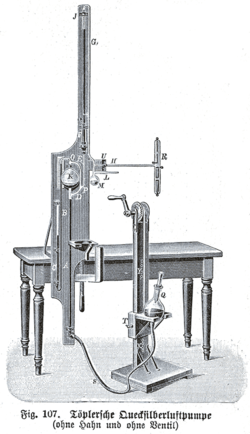Toepler pump

A Toepler pump is a form of mercury piston pump,[1][2] invented by August Toepler in 1850.
Operation
The principle is illustrated in the diagram. When reservoir G is lowered, bulb B and tube T are filled with gas from the enclosure being evacuated (through tube A). When G is raised, mercury rises in tube F and cuts off the gas in B and T at C. This gas is then forced through the mercury in tube D into the atmosphere. The end of tube D is bent upward at E to facilitate collection of gas (or vapor). By alternately raising G, a pumping action results. Clearly tubes F and D must be long enough to support mercury columns corresponding to atmospheric pressure (76 cm at sea level). Instead of using mercury to provide a valving action at C, it is possible to use a glass float valve.
References
- ↑ A. Roth (2 December 2012). Vacuum Technology. Elsevier Science. pp. 204–. ISBN 978-0-444-59874-5.
- ↑ Duward F. Shriver (5 November 1986). The Manipulation of Air-Sensitive Compounds. John Wiley & Sons. pp. 113–. ISBN 978-0-471-86773-9.
Further reading
- Vacuum Technology: Andrew Guthrie; John Wiley & Sons, Inc; New York and London; 1963
- R. W. Cahn (2001) The Coming of Materials Science, Pergamon, University of Michigan, p405.